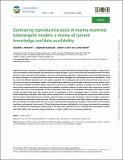Files in this item
Estimating reproductive costs in marine mammal bioenergetic models : a review of current knowledge and data availability
Item metadata
| dc.contributor.author | McHuron, Elizabeth A | |
| dc.contributor.author | Adamczak, Stephanie | |
| dc.contributor.author | Costa, Daniel P | |
| dc.contributor.author | Booth, Cormac | |
| dc.date.accessioned | 2023-01-24T12:30:10Z | |
| dc.date.available | 2023-01-24T12:30:10Z | |
| dc.date.issued | 2023-01-18 | |
| dc.identifier | 283085553 | |
| dc.identifier | a38ae9a1-61f0-41f9-b702-e8bc2880444e | |
| dc.identifier | 85151160812 | |
| dc.identifier.citation | McHuron , E A , Adamczak , S , Costa , D P & Booth , C 2023 , ' Estimating reproductive costs in marine mammal bioenergetic models : a review of current knowledge and data availability ' , Conservation Physiology , vol. 11 , no. 1 , coac080 . https://doi.org/10.1093/conphys/coac080 | en |
| dc.identifier.issn | 2051-1434 | |
| dc.identifier.other | Bibtex: 10.1093/conphys/coac080 | |
| dc.identifier.uri | https://hdl.handle.net/10023/26819 | |
| dc.description | Funding: This review was funded by the Office of Naval Research (N000142012392), with support from the Marine Mammal Commission (MMC 19-173). | en |
| dc.description.abstract | Reproductive costs represent a significant proportion of a mammalian female's energy budget. Estimates of reproductive costs are needed for understanding how alterations to energy budgets, such as those from environmental variation or human activities, impact maternal body condition, vital rates and population dynamics. Such questions are increasingly important for marine mammals, as many populations are faced with rapidly changing and increasingly disturbed environments. Here we review the different energetic costs that marine mammals incur during gestation and lactation and how those costs are typically estimated in bioenergetic models. We compiled data availability on key model parameters for each species across all six marine mammal taxonomic groups (mysticetes, odontocetes, pinnipeds, sirenians, mustelids and ursids). Pinnipeds were the best-represented group regarding data availability, including estimates of milk intake, milk composition, lactation duration, birth mass, body composition at birth and growth. There were still considerable data gaps, particularly for polar species, and good data were only available across all parameters in 45% of pinniped species. Cetaceans and sirenians were comparatively data-poor, with some species having little or no data for any parameters, particularly beaked whales. Even for species with moderate data coverage, many parameter estimates were tentative or based on indirect approaches, necessitating reevaluation of these estimates. We discuss mechanisms and factors that affect maternal energy investment or prey requirements during reproduction, such as prey supplementation by offspring, metabolic compensation, environmental conditions and maternal characteristics. Filling the existing data gaps highlighted in this review, particularly for parameters that are influential on bioenergetic model outputs, will help refine reproductive costs estimated from bioenergetic models and better address how and when energy imbalances are likely to affect marine mammal populations. | |
| dc.format.extent | 22 | |
| dc.format.extent | 1959290 | |
| dc.language.iso | eng | |
| dc.relation.ispartof | Conservation Physiology | en |
| dc.subject | QH301 Biology | en |
| dc.subject | SDG 14 - Life Below Water | en |
| dc.subject | MCC | en |
| dc.subject.lcc | QH301 | en |
| dc.title | Estimating reproductive costs in marine mammal bioenergetic models : a review of current knowledge and data availability | en |
| dc.type | Journal item | en |
| dc.contributor.institution | University of St Andrews. SMRU Consulting | en |
| dc.identifier.doi | 10.1093/conphys/coac080 | |
| dc.description.status | Peer reviewed | en |
This item appears in the following Collection(s)
Items in the St Andrews Research Repository are protected by copyright, with all rights reserved, unless otherwise indicated.

